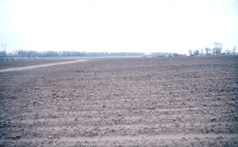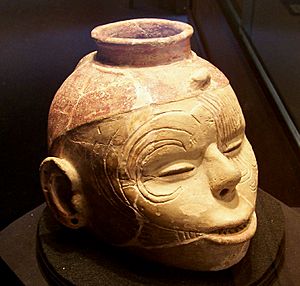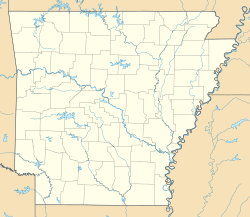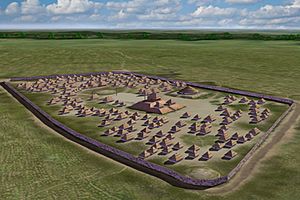Nodena site facts for kids
|
Nodena site
|
|

Fields at the Nodena site
|
|
| Nearest city | Wilson, Arkansas |
|---|---|
| Area | 305 acres (123 ha) |
| NRHP reference No. | 66000201 |
Quick facts for kids Significant dates |
|
| Added to NRHP | October 15, 1966 |
| Designated NHL | February 19, 1964 |
The Nodena site is an amazing archeological site in Mississippi County, Arkansas, United States. It's located east of Wilson, Arkansas, near the Mississippi River. From about 1400 to 1650 CE, an Native American village stood here. This village was protected by a strong wooden fence called a palisade.
Dr. James K. Hampson, an archaeologist, first found and studied the Nodena site. He owned the land where the site is located. Today, you can see many cool artifacts from Nodena at the Hampson Museum State Park in Wilson, Arkansas. Many archaeologists believe the Nodena site was part of the Pacaha area. This area was visited by the Spanish explorer Hernando de Soto in 1542.
In 1900, a prehistoric mastodon skeleton was found about 2 miles (3.2 km) south of the Nodena site. In 1964, the Nodena site was named a National Historic Landmark. Two years later, in 1966, it was added to the National Register of Historic Places.
Contents
Discovering the Nodena Culture
The Nodena site is very important for understanding the Late Mississippian culture. This culture existed from about 1400 to 1700 CE. The Nodena culture included many villages along the Mississippi River. These villages were located between the Missouri Bootheel and Wapanocca Lake.
The Nodena culture existed at the same time as other groups like the Menard, Tipton, Walls, and Parkin cultures. The Parkin Indian Mound is another important village site. It is about 30 miles (48 km) southwest of Wilson.
In the early 1540s, the Spanish Hernando de Soto Expedition explored this region. They likely visited several Nodena culture sites. Many experts think the Nodena area was the "Province of Pacaha" mentioned by de Soto. The Parkin site might have been the "Province of Casqui".
The Nodena people were part of the Southeastern Ceremonial Complex. This was a huge network for religion and trade. Through this network, they got special materials like chert (a type of rock) and whelk shells.
Life in Nodena Village (1400–1650 CE)
The Nodena village was about 15 acres (6.1 ha) in size. It was built on a horseshoe-shaped bend of the Mississippi River. This was about 5 miles (8.0 km) east of Wilson, Arkansas. The things found at the site show that people lived here from 1400 to 1650 CE.
The village had between three and eight mounds. Two of these were large flat-topped mounds. The biggest one, called "Mound A", was about 111 feet (34 m) wide and 120 feet (37 m) long. It stood about 15.5 feet (4.7 m) high. This mound had two levels, with structures built on top.
"Mound B" was another large mound, about 117 feet (36 m) by 111 feet (34 m) and 4 feet (1.2 m) tall. A round building, about 60 feet (18 m) across, was found on its top. The site also had big open areas called plazas. Dr. Hampson also found what he called a "chunkey field". This was a special area for playing a game.
A circular mound, "Mound C", was near the chunkey field. It was about 93 feet (28 m) wide and 3 feet (0.91 m) high. Many graves of men were found buried under this mound.
The houses in the village were built in a very organized way. They lined up with the mounds, showing that the whole village was carefully planned. Spanish explorers like de Soto said that the villages of the Pacaha and Nodena people were the most organized they had seen.
The Spanish also noted that there were few trees near the villages. This was probably because people cut them down for fuel and building materials. Homes were made from wattle and daub, which is a mix of woven branches and mud. Their roofs were made of thatch.
A strong palisade (wooden fence) surrounded the village for defense. It had special lookout points called bastions. These bastions had slots for archers to shoot from. The people of Casqui and Pacaha often fought each other. Because of this, most large villages in the area had these strong defensive fences.
The de Soto explorers also wrote that the region had powerful leaders called paramount chiefs. These chiefs lived in main towns and ruled over smaller villages. The Nodena site was likely either a main town or a large satellite town of the Pacaha province.
Nodena Pottery and Art

Human head effigy pot at the Hampson Museum
|

S.E.C.C. ogee motif pot from the Nodena site
|
Most of the pottery found at Nodena is called Mississippian Bell Plain. It was a light brown color and contained crushed mussel shells. This made the pottery strong but not very smooth. Other pottery found was much finer, with very finely ground shells. Some even looked like they had no shells at all.
The Nodena people often placed a bowl and a bottle in graves with the dead. These were usually made of the finer pottery. The shapes and decorations on these pots were very different. Some had bright, swirly designs. Others were detailed effigy vessels, shaped like human heads, animals, or hunters.
The Nodena people made their pottery by building it up from strips of clay. Then, they smoothed it out by hand. They did not use a potter's wheel, which was unknown in Eastern America. They used special paints called slips to decorate their pots. They used galena for white, hematite for red, and sometimes graphite for black. A popular design was a red swastika on a white background. Sometimes, they carved designs into the pottery, but this was rare.
Head Shaping
The people of the Nodena culture practiced artificial cranial deformation. This is also called head flattening. When babies were very young, they were strapped to a special carrier. This gently shaped their skulls as they grew.
Many of the human skulls found at the Nodena site show this head shaping. Their foreheads and the backs of their heads were flattened. Out of 123 skulls found by Dr. Hampson, only six looked "normal". This means they did not show signs of head shaping.
Head shaping does not affect how the brain works. It only changes the shape of the skull bones. Many Native American tribes practiced this, including the Choctaw, though it later became less common.
Farming and Food
The Nodena people were excellent farmers. They grew a lot of maize (corn), as well as other important crops. These included beans, squash, sunflowers, and gourds. They also gathered wild foods like pecans and persimmons.
The Spanish explorers said the area was heavily farmed. They also noted that it was the most populated place they had seen in "La Florida" (their name for the southeastern US). The Spanish saw wild fruit and nut trees. This suggests the Nodena people left these trees standing when clearing land for corn.
The Nodena people also hunted animals like whitetail deer, squirrel, rabbit, turkey, and mallard ducks. They also fished for alligator gar, catfish, drum, and mussels.
Language of the Nodena People
The Nodena people likely spoke languages from the Tunican or Siouan language families. We know that the Tunica people were in the area when de Soto arrived. It's possible that all the related groups in this region spoke Tunican languages. Caddoan speakers lived to their west and south.
However, by the time other Europeans like Jacques Marquette arrived in the 1670s, the area was home to the Dhegiha Siouan-speaking Quapaw people. Scientists have tried to link the pottery styles and words from de Soto's writings to modern tribes. But so far, they haven't been able to make a clear connection.
Dr. James K. Hampson: The Discoverer
The museum for the Nodena site is named after Dr. James K. Hampson (1877–1956). He owned the Hampson Plantation, where the Nodena site is located. He was the first archaeologist to dig up and protect the artifacts from the Nodena site. He also carefully recorded everything he found.
The Hampson Museum State Park in Wilson, Arkansas displays many early Native American artifacts from the Nodena site. The museum teaches about the Nodena people's farming, hunting, social life, religion, and politics. You can see stone and shell artifacts, as well as pottery, to learn about their culture.
Prehistoric Mastodon Discovery
Mastodons were huge, prehistoric animals that looked a lot like modern elephants. They lived in North America for almost 4 million years. They eventually disappeared about 10,000 years ago.
In 1900, Dr. James K. Hampson recorded the discovery of a mastodon skeleton. It was found on Island No. 35 in the Mississippi River. This island was about 2 miles (3.2 km) south of the Nodena site. Sadly, by 1957, the site where the mastodon was found was reported as destroyed.




